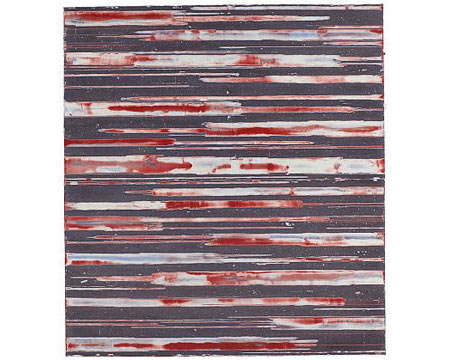
The structural base of Mark Harrington’s exhibition begins with the visceral quality of Abstract Expressionism and the reductive simplicity of Minimalism. Into this mix, he adds depth of field of photography. The rigor of working with three distinct visual disciplines yields a formidable body of work, a dynamic interplay of coalescence and contradictions that catch viewers off guard by having to negotiate territories that are both familiar and unfamiliar.
Rows of torn and ripped colored horizontal stripes rhythmically alternating against bare negative stripes have a deceptively “easy” appearance. Once the image is absorbed, what seems like a simple flag-like striped canvas reveals complex thought processes. The overall horizontality, even in a vertical composition, appears as if the image continues, going off somewhere to the left and to the right, to a place without end. The stripes also provide a ladder effect of going up and down. There is no sense of top and bottom, but a suggestion, rather than an actuality, of passage – a flow through time and space, a crossing of undefined fields, and an appearance of great volume.
Harrington’s formal means emphasize varied depths of field. The image moves from apparently being close up to faraway, blurred yet clear, producing a quiet rocking back and forth motion. And because each earth-tone stripe is irregular and roughly torn, we plow through its rows at different speeds. Consequently, with its visual pulls heading in multiple directions, each canvas is endowed with an active use of space and irregular rhythms that seems to exude a chanting of many tonal voices.
Each group of stripes is composed of thickly and thinly applied bands of paint. Harrington invests much time finding and making tools that allow him to work the surface, while mixing his own recipes of products that yield his distinct painterly look and feel. A composite of varying textural marks move across the canvas; they come from the artist’s hand, the instruments applied to the surface, and the chemical makeup of the paint mixture itself. The marks are highly controlled yet appear spontaneous, albeit in fairly straight, parallel lines.
Key factors in Harrington’s holistic approach are his personal life experiences, and a keen ability to see and combine relationships that others might not recognize. Harrington, an American, resides in Bavaria. From the age of fourteen he lived in many parts of Europe, absorbing various cultural aesthetics. His influences are many, but not readily discernable. For example, Harrington made an extensive study of frescos, the effects of ancient walls he constantly sees around him. He considers how the nature of such surfaces can apply to contemporary aesthetics. The tearing of canvas conveys a sense of wall fragments in the wearing away and decay of the past. The freshly overlaid paint becomes the present, and history implicitly lurks behind each newly-made mark. From his American heritage he is drawn to the works of Herman Melville. Melville gives Harrington his great sense of the exotic and romantic, his quest for idealism and a reach for the transcendent that becomes apparent in the meditative effects of each canvas. The artist is also drawn to flags, the red, white, and blue of the U.S. Flag, along with the tricolors of France, a theme more identifiable in the stripped configurations. Therefore, the multiple structures that comprise this exhibition reference symbols that embrace various past and present civilizations as well as the artist’s diverse personal experience.
Lastly, there is Harrington’s knack for making connections and compressing more than we can absorb at once is impressive. There is a great deal to see, contemplate and relish in each work.
Published courtesy of ArtSceneCal ©2010
